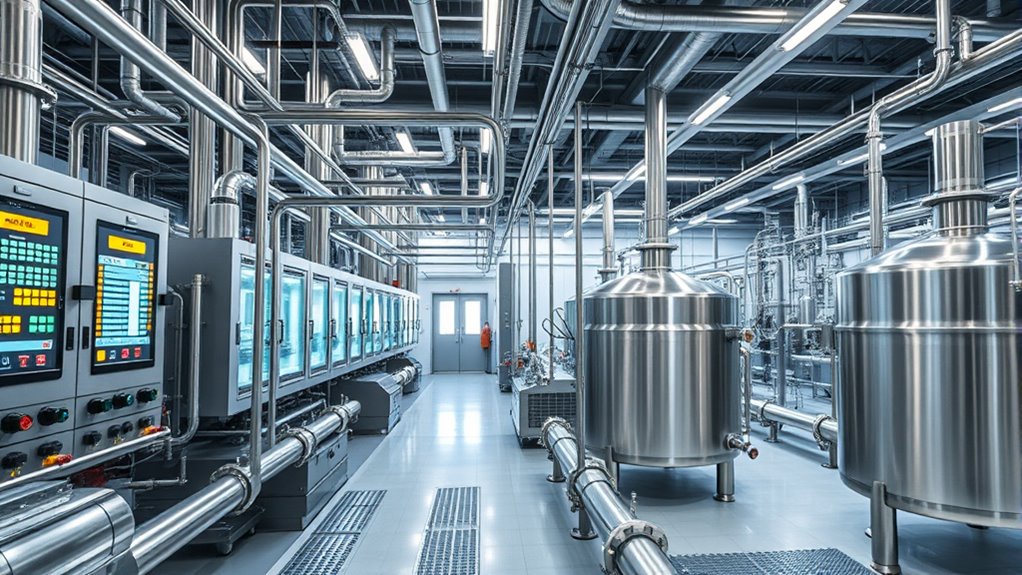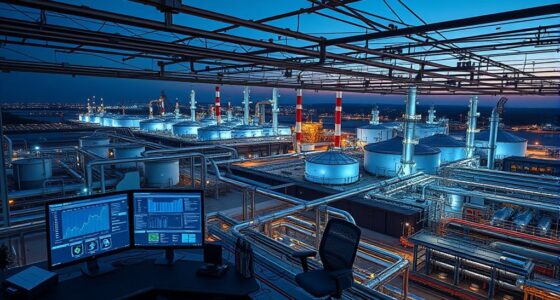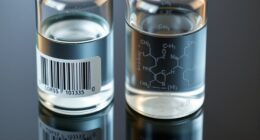Continuous manufacturing offers a more efficient and consistent approach than batch processing, enabling you to produce larger volumes with less waste and lower costs. It provides tighter process control, ensuring product uniformity and quality. Plus, it’s more sustainable, reducing resource use and emissions. With greater flexibility, you can quickly adapt to market demands and customize products. If you’d like to explore how this shift could impact the future of chemical production, there’s more to uncover ahead.
Key Takeaways
- Continuous manufacturing offers higher efficiency, larger scale, and cost savings compared to batch processes.
- It provides superior process control and product consistency through automation and real-time monitoring.
- Continuous methods are more sustainable, reducing resource consumption, waste, and emissions.
- Batch processes offer greater flexibility for customization and quick adaptation to market demands.
- The future of chemical production will likely integrate both methods, balancing efficiency with flexibility and safety.
Comparing Production Volume and Efficiency
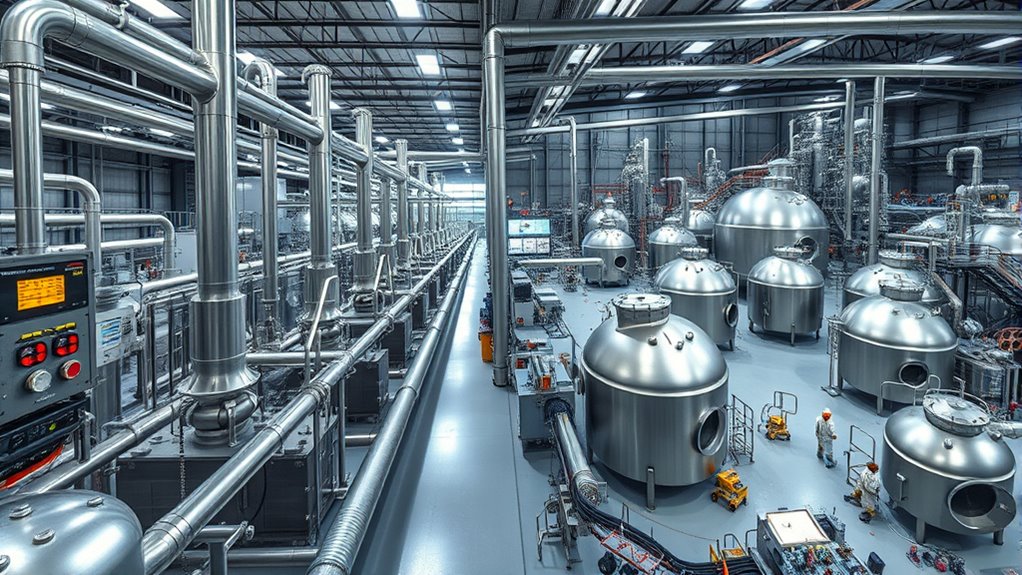
When comparing production volume and efficiency, continuous manufacturing clearly outperforms batch processing in several key areas. You’ll find that continuous methods produce larger volumes because they operate without interruption, unlike batch processing which’s limited by material capacity and equipment size. This continuous approach also benefits from economies of scale, making high-volume production more cost-effective. It’s ideal for fulfilling large orders efficiently, as production keeps running until the order is complete. Additionally, continuous manufacturing is highly automated, reducing manual work and lowering unit costs. Equipment utilization is maximized since machinery runs continuously, which cuts down on downtime and maintenance. Furthermore, continuous processes can be more easily integrated with advanced control systems to maintain consistent product quality across large batches, reducing variability. This integration helps in maintaining product consistency and meeting stringent quality standards.
Process Control and Product Consistency

Automation and process control are central to maintaining the advantages of continuous manufacturing. You benefit from automated control systems that regulate raw material flow and product output, ensuring steady conditions and reducing variability. These systems help maintain consistent process parameters. Sensors and feedback loops monitor parameters like temperature, pressure, and composition in real time, allowing immediate adjustments that keep product quality consistent. Unlike batch processes, which rely on periodic sampling and manual interventions, continuous systems provide tighter control and fewer process deviations. This consistent operation results in less batch-to-batch variability, improved product uniformity, and enhanced safety. Additionally, inline quality monitoring enables quick detection and correction of issues, ensuring that product quality remains high throughout production.
Environmental Impact and Sustainability

Continuous manufacturing offers notable environmental benefits by reducing resource consumption and minimizing waste. It uses less water than batch processes, helping conserve essential water resources. Energy use drops considerably, cutting greenhouse gas emissions and supporting climate goals. This efficiency also reduces the overall carbon footprint of production. Waste generation decreases because continuous systems optimize material use and avoid overproduction. This process also lowers air pollution by reducing emissions of nitrogen oxides and sulfur oxides. Although not directly tied to land use, its efficiency can reduce land needed for raw material storage and waste disposal. Additionally, process optimization techniques improve overall process sustainability and resource efficiency. Sustainability metrics like Process Mass Intensity (PMI) and Global Warming Potential (GWP) favor continuous manufacturing, showing lower resource input and emissions. Overall, this approach advances environmental sustainability by making chemical production cleaner and more efficient.
Flexibility, Customization, and Market Responsiveness

While continuous manufacturing excels in efficiency and environmental sustainability, batch processes offer superior flexibility and adaptability to changing market demands. You can easily modify batch equipment to produce different products by adjusting raw materials and settings. This allows quick shifts in production based on market needs, especially for specialty chemicals with complex synthesis processes. Batch manufacturing also enables customization, letting you tailor formulations to meet specific customer requirements without significant equipment changes. When market trends shift or new products are needed, you can respond swiftly by switching production or adjusting raw materials. This flexibility makes batch processes ideal for small to medium-scale productions, where responsiveness and customization are vital. While continuous methods excel in high-volume scenarios, batch processes give you the agility to adapt quickly to market changes. Incorporating auditory processing techniques into workforce training can further enhance operational responsiveness and employee adaptability.
Safety Considerations and Workforce Dynamics
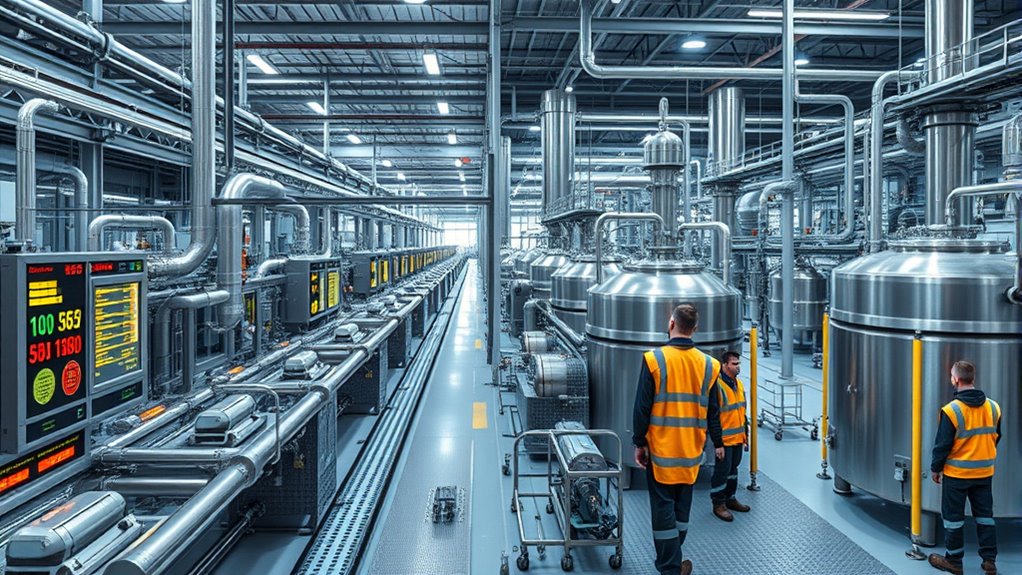
Ensuring safety in chemical manufacturing requires strict adherence to standards and proactive hazard management, especially when using continuous processes that involve hazardous chemicals. You must implement Process Safety Management (PSM) and comply with OSHA regulations to manage risks effectively.
Regular safety audits and international safety guidelines help identify potential hazards and maintain compliance. Hazard identification through chemical risk assessments, engineering controls, and PPE reduces exposure risks.
Emergency response planning and continuous process monitoring are essential for quick hazard mitigation. Additionally, employing AI-driven data analysis can enhance predictive safety measures and early hazard detection.
Workforce dynamics also play a critical role: training, safety workshops, and skill development foster a safety-conscious culture. Managing shift patterns to prevent fatigue, encouraging worker engagement, and establishing clear communication channels ensure safety remains a top priority, regardless of production method.
Frequently Asked Questions
How Does Initial Investment Cost Differ Between Continuous and Batch Systems?
You’ll find that initial investment costs differ considerably between continuous and batch systems.
Continuous processes usually require a higher upfront investment because of specialized, complex equipment and advanced technology.
In contrast, batch systems are less expensive initially, with simpler, smaller equipment.
While continuous systems cost more initially, they can save you money long-term through increased efficiency and reduced waste, especially in high-volume production scenarios.
What Are the Key Regulatory Challenges Unique to Each Production Method?
They say “forewarned is forearmed,” and understanding regulatory challenges helps you stay ahead. For continuous manufacturing, you face hurdles like evolving standards, real-time data management, and global harmonization issues, making approval processes complex.
Batch manufacturing, meanwhile, struggles with rigid frameworks, lengthy validation, and adapting to new tech. Both demand rigorous quality assurance, but each has unique regulatory roadblocks that can slow innovation and implementation.
How Does Product Lifecycle Management Vary for Continuous Versus Batch Processes?
In managing product lifecycles, you’ll find that batch processes allow for more flexibility during development and modifications.
Continuous processes, however, require detailed planning upfront, with tighter control and real-time data collection.
You can adapt batch methods more easily during early stages, while continuous systems excel at maintaining consistent quality and efficiency once the product is finalized.
What Training Requirements Are Necessary for Operators in Each System?
You need specific training to operate each system effectively. For continuous manufacturing, you must master real-time quality assurance, process control software, and GMP compliance, with ongoing education to adapt to new tech and regulations.
For batch processes, focus on mastering SOPs, batch record keeping, manual quality checks, and safety procedures.
Both require strong equipment operation skills, safety training, and a commitment to continuous learning to guarantee smooth, compliant production.
How Do Supply Chain Considerations Influence Choice of Manufacturing Approach?
Supply chain considerations heavily influence your choice of manufacturing approach. If you prioritize steady raw material flow and reduced inventory, continuous manufacturing is ideal, offering consistent output and efficiency.
However, if your supply chain faces variability or risks, batch processing provides flexibility and easier inventory management.
You need to evaluate factors like supplier reliability, transportation costs, and regulatory compliance to select the approach that best supports your supply chain’s resilience and goals.
Conclusion
As you navigate the future of chemical production, remember that continuous manufacturing is like a flowing river—steady, adaptable, and sustainable—offering a clear path forward. Batch processes, on the other hand, resemble seasonal tides—flexible but fluctuating. Embracing the river’s clarity can lead you toward innovation and efficiency, shaping a resilient, eco-friendly industry. Choose the flow that aligns with your vision, and let it guide your journey into tomorrow’s chemical landscape.
